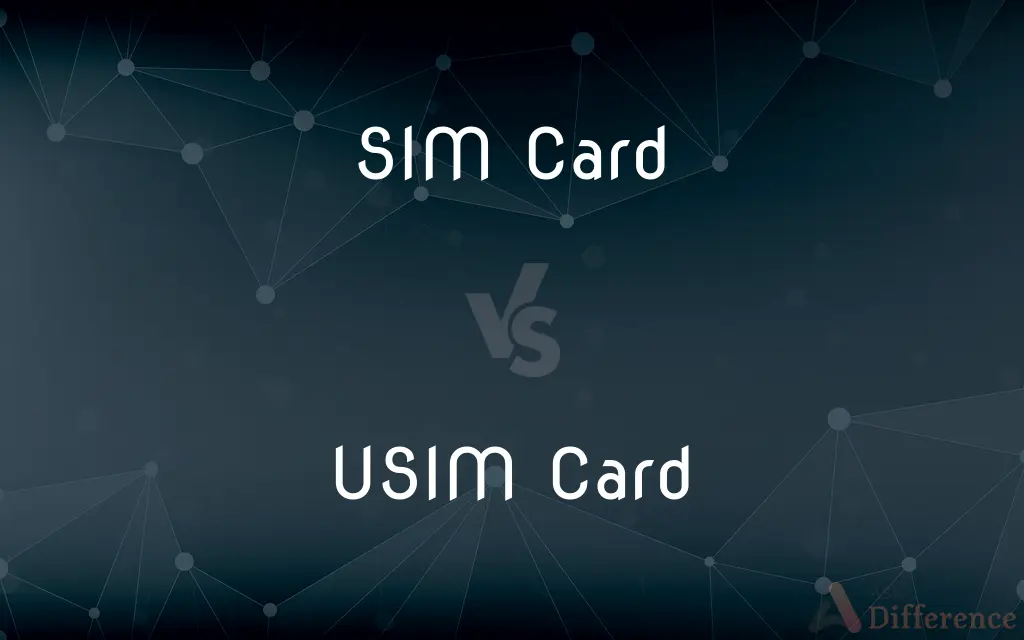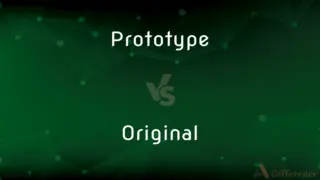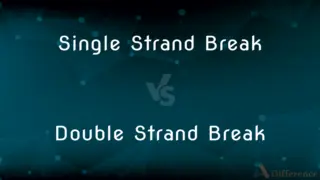SIM Card vs. USIM Card — What's the Difference?
Edited by Tayyaba Rehman — By Fiza Rafique — Published on November 15, 2023
SIM Card is a standard card for GSM networks, while USIM Card is an upgraded version for 3G and beyond.

Difference Between SIM Card and USIM Card
Table of Contents
ADVERTISEMENT
Key Differences
A SIM Card, or Subscriber Identity Module, has been in use since the early days of GSM (2G) cellular technology. The USIM Card, or Universal Subscriber Identity Module, was introduced with the advent of UMTS (3G) networks.
While both the SIM Card and USIM Card provide security features, the USIM Card offers enhanced security measures to protect user data, making it harder for potential eavesdroppers to access user information.
The basic SIM Card carries essential information like the International Mobile Subscriber Identity (IMSI) and keys for encryption. In contrast, the USIM Card can store more applications, including those for mobile commerce.
Both cards store personal data, but the USIM Card typically offers more storage capacity than the traditional SIM Card, accommodating a larger phone book and more SMS messages.
While a SIM Card may not work in devices that are designed for 3G networks and beyond, a USIM Card is typically backward compatible, meaning it can function in 2G (GSM) handsets.
ADVERTISEMENT
Comparison Chart
Origin
Introduced with GSM (2G) networks.
Developed for UMTS (3G) and later networks.
Security
Basic encryption and security.
Enhanced security and encryption measures.
Applications
Limited to basic mobile functions.
Can store more applications.
Storage Capacity
Limited storage for contacts and messages.
Greater storage for contacts and messages.
Compatibility
Best for 2G devices.
Works with 3G and later but backward compatible.
Compare with Definitions
SIM Card
The SIM Card identifies and authenticates a user's subscription on a network.
Without a SIM Card, my phone can't connect to the cellular network.
USIM Card
The USIM Card provides advanced security features for user protection.
I prefer using a USIM Card because of its improved security measures.
SIM Card
A SIM Card is a small chip that stores subscriber data for mobile devices.
I lost my phone, but I kept my SIM Card, so I didn't lose my contacts.
USIM Card
Compared to traditional SIM Cards, USIM Cards offer greater storage.
I can save more contacts on my USIM Card than my old SIM Card.
SIM Card
The SIM Card provides security features to protect user data.
My SIM Card is PIN protected to keep my data safe.
USIM Card
A USIM Card is an enhanced version of the SIM Card for 3G and later networks.
My new smartphone came with a USIM Card to support faster data speeds.
SIM Card
SIM Cards hold personal information such as phone numbers and text messages.
I transferred my old SIM Card to my new phone to keep my messages.
USIM Card
USIM Cards are backward compatible with 2G handsets.
I used my USIM Card in an older phone, and it worked just fine.
SIM Card
A SIM Card is essential for GSM-based cellular communications.
I had to buy a new SIM Card when I switched carriers.
USIM Card
USIM Cards can store additional applications, including mobile commerce.
My USIM Card has a payment app that lets me shop without a physical card.
Common Curiosities
Is the USIM Card more secure than the SIM Card?
Yes, the USIM Card offers enhanced security measures compared to the traditional SIM Card.
Can I use a SIM Card in a 3G device?
It depends on the device, but in general, a USIM Card is better suited for 3G and beyond.
Is a USIM Card backward compatible?
Yes, a USIM Card is typically backward compatible with 2G handsets.
What happens if I lose my SIM Card or USIM Card?
If lost, you may lose stored data, but the provider can issue a new one with the same number.
Do both SIM Card and USIM Card have PIN protection?
Yes, both can be PIN protected for added security.
Which has more storage: SIM Card or USIM Card?
The USIM Card generally offers more storage than the traditional SIM Card.
How do I transfer data from my SIM Card to a USIM Card?
Most carriers can assist with transferring data when you upgrade or switch cards.
What is a SIM Card?
A SIM Card is a small chip that stores subscriber data for mobile devices, mainly used in 2G networks.
Do I need a USIM Card for 5G?
While USIM can work, newer cards, like eSIM, are emerging for 5G technologies.
What is a USIM Card?
A USIM Card is an upgraded version of the SIM Card, primarily designed for 3G and later networks.
Can I switch from a SIM Card to a USIM Card?
Yes, if your device and network support it, you can upgrade to a USIM Card.
What data is stored on a SIM Card and USIM Card?
Both store personal data like contacts, messages, and network authentication details.
Can I use my SIM Card or USIM Card in another country?
It depends on your carrier's roaming agreements and the compatibility of the network in the other country.
Is the physical size of the SIM Card and USIM Card the same?
Both come in various sizes, like nano, micro, and standard, but the determining factor is their technical specifications.
Are SIM Card and USIM Card the only types of subscriber identity modules?
No, there are other types like eSIM, but SIM and USIM are among the most common.
Share Your Discovery

Previous Comparison
Prototype vs. Original
Next Comparison
Single Strand Break vs. Double Strand BreakAuthor Spotlight
Written by
Fiza RafiqueFiza Rafique is a skilled content writer at AskDifference.com, where she meticulously refines and enhances written pieces. Drawing from her vast editorial expertise, Fiza ensures clarity, accuracy, and precision in every article. Passionate about language, she continually seeks to elevate the quality of content for readers worldwide.
Edited by
Tayyaba RehmanTayyaba Rehman is a distinguished writer, currently serving as a primary contributor to askdifference.com. As a researcher in semantics and etymology, Tayyaba's passion for the complexity of languages and their distinctions has found a perfect home on the platform. Tayyaba delves into the intricacies of language, distinguishing between commonly confused words and phrases, thereby providing clarity for readers worldwide.













































